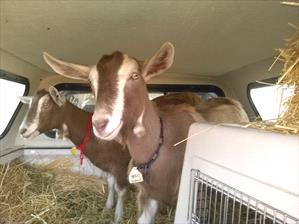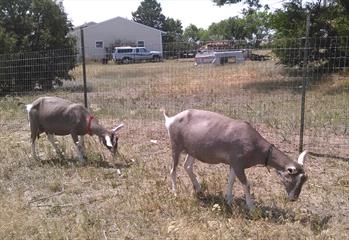two goats in back of pickup truck

Photo by LaDonna Foley
Who knew you could just pop goats into a pickup truck and drive them across the country by yourself without batting an eyelash?
If you want to make it easier, it helps if a goat person is along for the ride, particularly when one goat is nursing.
If you want to make it really easy, bring along a professional herdsman.
My coworker LaDonna Foley lives in Wyoming, as do I. LaDonna is a goat person while I am a crazy cat lady who once had too many clinic cats. We both attend work meetings in Davis, California, and sometimes we drive. Not together, since we have different schedules before and after, each having an elderly aunt along the route to check in on.
Besides, lately Ladonna has been bringing goats back with her, and since I want to stay married, I come home without additional cats. There’s a Toggenburg breeder she likes who conveniently lives near our office, so she drives out goat-free and goes home loaded with goats.
Perhaps I should mention that LaDonna used to run the goat barn at the UC Davis Animal Science Department, where she managed anywhere from 40 to 267 goats at one time. I can practically hear some veterinarians saying, “Oh, that’s where I heard that name before!” She started as a volunteer during her freshman year in college because her mother wouldn’t let her bring her horse to college for fear she wouldn’t study. (Hmmm, sounds familiar and makes me wonder if we are related somewhere along the family tree!) LaDonna worked up to a part time job, and eventually was hired as herdsman after she graduated. (If a bunch of goats are running together, are they officially a Thundering Herd?)
On her second trip, she brought back a 9-month old goat named Rowena and 20 straws of goat semen. She couldn’t mistake them for regular straws while driving through McDonalds because they have to be contained in liquid nitrogen or within 15 minutes they defrost into wasted money.
With the appropriate paperwork for transporting animals inter-state in hand, she embarked on her trial run in the long-distance goat moving event in a 2008 Dodge Dakota. Tucked into the back of the truck under a camper shell were two adult goats named Flower and Ruby, along with Ruby's nursing buckling. The drive is about 16 to 18 hours, plus stops, a long nearly straight shot down Interstate 80. The topper has sliding windows in the front and sides for good ventilation. She bought this truck several years ago with the idea of transporting goats. She put down a thick rubber bed mat so the “floor” of the pseudo-goat enclosure isn’t slippery, and it was bedded deeply with straw to help keep them warm. The does had been housed in separate parts of the breeder’s yard and LaDonna didn’t want Flower to interfere with the buckling’s nursing from Ruby, so while the truck was in motion the buckling stayed in the crate.
At this point most folks ask the same thing: what about when they have to go to the bathroom? Is there a bathroom in the back of the truck?
Of course there is. It’s the back of the truck.
She started out with everything very clean and dry. The back of the truck has plenty of room for two adult goats, a buckling, and a person to move around, even with the big dog/goat crate back there. The straw she put down was deep that so any urine could drain through and the animals would stay dry. Goats normally defecate small, dry pellets so cleaning wasn't an issue for the one day in the truck. When she stopped, she’d fill the water bucket and put it in the truck so they had a chance to drink. LaDonna’s past experience shows that goats don't like to drink when the vehicle is moving. She stopped every four to six hours. She didn’t let them out of the truck because she was afraid she might not get them back in by herself. She got into the back to milk Ruby, and pet the goats and play with them. Thankfully, Ruby stood like a rock for milking even though she wasn’t tied to a stanchion, as she was used to.
“Some alfalfa pellets in a bucket were all I needed for her to hold still. Flower got some also at the other end of the bed so she wouldn't be a pest,” LaDonna said. “At several of the rest stops other drivers came over to chat when I was in the back with the camper door up. Many people haven't had a chance to get close to a goat before and are interested.”
Toggenburg goats in pasture

Flower and Ruby enjoy doing goaty things at their home. Photo by LaDonna Foley.
She also slept in a motel for about five hours and was able to back the truck up to her door so she could check on them in the 20°F temperature. Healthy goats with good rumens put out a lot of heat. They stayed very comfy with closed windows and the deep straw. As usual, she worried for nothing and they were happy on that December night.
The buckling went to someone else and is now a happy pasture pet. Ruby, Flower, and Rowena are family now, not just the seeds of LaDonna’s Toggenburg herd. They goof around playing king of the mountain on their upturned tubs, their home version of a goat mountain, and generally amuse themselves doing goaty things. Flower likes to herd the ducks, which would be normal for a dog but kind of strange for a goat. They’re breeding and being happy, living the good life with a goat lover who knows exactly how to care for them best.
LaDonna makes soap, cheese, butter and ice cream with their milk. Yum!
She’s driven out to California twice now for goats, but she’s going again next week. She wants to pick up some kids (the caprine type, not two-leggers) from the same breeder who at that point will still be nursing from a bottle – a new transportation wrinkle! She will also stop by and check on her elderly aunt. I check on my elderly aunt when I drive out there too, but I’m not driving home with a van full of cats, nor do I have to hose out my vehicle when I get home (maybe I should?). I greatly admire anyone who can transport these beauties so well.